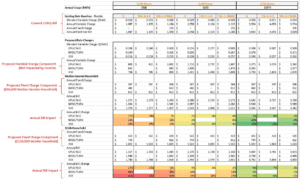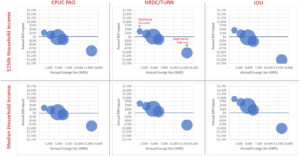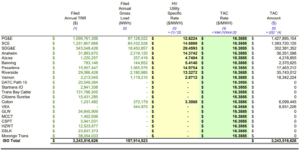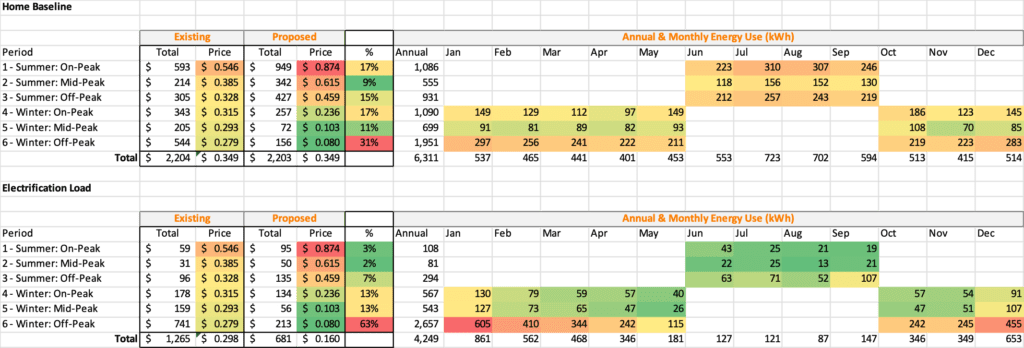
Clean Coalition’s streamlined Fixed Charge proposal satisfies legal requirements while preempting another attack by the utilities on Local Solar
In a blog post written by the Clean Coalition, we explain why a Fixed Charge cannot be considered the silver bullet solution to make electric rates affordable for all Californians.

Clean Coalition’s streamlined Fixed Charge proposal
Assembly Bill 205 (2022) was passed to address the existing crisis of unaffordable electricity rates, particularly for lower-income Californians, by eliminating the cap on Fixed Charges (for residential customers) and mandating that the Public Utilities Commission authorize a residential Fixed Charge by 2024. A legally compliant Fixed Charge must have at least three different tiers based on income, ensuring that low-income households pay less than wealthier Californians without changing energy consumption patterns. The Clean Coalition’s streamlined proposal meets each statutory requirement of AB 205 and is simple to implement, pragmatically preempting what is clearly another attack on Local Solar & customer choice by the utilities, like the recent NEM 3.0 decision & the VNEM proposed decision.
The rest of this article will answer the following nine questions:
- What is the Clean Coalition’s Fixed Charge proposal?
- Will a Fixed Charge improve the affordability of electricity rates in the short or long-term?
- What is needed for Californians to be incentivized to electrify?
- What is the methodology behind the Clean Coalition’s proposal?
- Why is a low Fixed Charge superior to higher Fixed Charge, if a high Fixed Charge will result in a greater reduction of the volumetric rate?
- What are the main cost drivers leading to increasing electricity rates?
- What is the value derived from volumetric rates?
- What will the effect of a high Fixed Charge be on deployments of Local Solar?
- Does a Fixed Charge make sense in the overall transition to real time rates?
1. What is the Clean Coalition’s Fixed Charge proposal?
The Clean Coalition’s streamlined Fixed Charge proposal is structured to collect only the truly fixed costs embedded in electricity rates. Residential electricity rates are currently collected entirely on a volumetric basis ($/kWh) with transparent price signals being sent to customers based on how strained the grid is during different times of the day. The more strained the grid is, especially during peak periods from 4-9pm, the higher the price – and vice versa for off-peak periods. A low Fixed Charge, like the one the Clean Coalition proposes, minimizes overall electricity rates without distorting existing pricing signals that incentivize intelligent use of electricity. Alarmingly, Fixed Charge distortions would cause unnecessary and exorbitant investments in the transmission grid that would raise electricity prices for all ratepayers, whether rich, poor, or anywhere in between. Conversely, in addition to ensuring that electricity consumption is intelligently matched to minimize transmission costs, transparent pricing signals incentivize energy efficiency and conservation by all ratepayers, again whether rich, poor, or anywhere in between.
Our proposal meets all legal requirements in AB 205, ensuring all of the following benefits:
-
- The lowest socioeconomic ratepayers will save money on their electricity bills.
- Rates retain a high differential between on-peak and off-peak price to ensure that unnecessary transmission investments do not raise electricity rates for all ratepayers, whether rich, poor, or anywhere in between.
- Transparent incentives for efficiency, conservation, and self-generation are maintained.
Customer-sited renewables, efficiency, and load shaping will be essential tools to save all ratepayers from hundreds of billions of dollars in avoidable transmission infrastructure over the next two decades. This table shows the monthly Fixed Charges that would be added to three incomes levels to satisfy the requirements of AB 205 without blinding ratepayers such that they become ignorant consumers of electricity that result in huge cost increases to all ratepayers.

Clean Coalition’s streamlined Fixed Charge proposal with tiers based on the Federal Poverty Level (FPL)
As seen in the table above, under the Clean Coalition’s proposal each of the three tiers will be assessed a differently priced Fixed Charge. The lowest income tier (CARE customers) will pay $0 per month while the next income tier (FERA customers) will pay $5 per month, resulting in savings for all low-income ratepayers. Importantly, the savings from the reduced monthly Fixed Charge will accrue on top of existing bill savings that are provided via the CARE and FERA programs. Ratepayers in the California Alternate Rates for Energy (CARE) program currently receive a 30-35% bill credit each month. All Californians under 200% of the Federal Poverty Level (FPL) are eligible for CARE. On the other hand, ratepayers between 200 and 250% of the FPL are eligible for an 18% bill credit under the Family Electric Rate Assistance (FERA) program. The low Fixed Charges for CARE and FERA customers represent additional subsidies that will be enjoyed by all defined tiers of low-income ratepayers in California.
Depending on the utility service territory, all other Californians will pay a Fixed Charge of between $12.77 and $18.51, which will at least maintain the amount that utilities currently collect via the existing minimum bill approach without blinding customers and causing them to use electricity when it will result in unnecessary investments in transmission infrastructure and cause massive cost increases to all ratepayers. The Clean Coalition’s proposal ensures immediate savings for low-income ratepayers while preserving incentives for energy conservation, efficiency, and electrification, setting the stage to save the ratepayers hundreds of billions of dollars in avoided transmission investments over the next two decades alone.
2. Will a Fixed Charge improve the affordability of electricity rates in the short or long-term?
The short answer is that implementing a Fixed Charge is more of a short-term affordability solution. A low Fixed Charge, like the one the Clean Coalition is proposing, will have short-term benefits without compromising long-term affordability. On the other hand, a high Fixed Charge may create short-term savings for some – at the cost of upending key strategies for achieving the state’s decarbonization and electrification goals – but increase costs for everyone in the long-term. A Fixed Charge is a temporary solution meant to buy down rates and provide low-income customers with a financial respite. However, without addressing the underlying cost drivers (e.g., transmission spending) leading to rate increases that far outpace inflation, electricity bills will be more unaffordable than ever. Thus, a Fixed Charge is an attempt to solve for a symptom rather than addressing the root cause of the problem. Reducing a symptom might improve present conditions but will likely lead to much more difficulty down the road unless the central issue is dealt with properly.
For example, a high Fixed Charge would reduce the volumetric rate just enough to mask the severity of the affordability crisis, downplaying the need to both substantially reform rates and curb over-spending on transmission infrastructure. A high Fixed Charge will also not necessarily make rates more affordable for all residential customers; some groups, like median-income renters, could see significant monthly bill increases that cannot be reduced by on-site energy generation or energy efficiency. Flagstaff Research conducted an analysis of the three highest Fixed Charge proposals (below) – from the utilities (IOU), NRDC/TURN, and the Public Advocates Office (PAO) – that considers bill impacts for low, medium, and high usage households making $84,000 and $150,000.
Flagstaff Research analysis of bill impacts in SCE’s service territory
The resulting bill impacts are shown numerically and as colors, with the greatest savings delineated by green colors and the greatest bill increases shown in red colors. For most low-and medium-usage households, there is a large (double digit) increase in the monthly bill. Under the IOU’s proposal, low-usage households making $150,000 would see a bill increase of over 40%, without any change in actual energy consumption patterns. In California, many renters would be included in this category. Medium-sized households making $84,000 see very little change or a slight bill increase. The greatest bill savings accrue to large-sized households that consume the greatest amount of energy. The same trend can be visualized more clearly in a bubble chart, as can be seen below. Single family households that have high electricity use and that correlate to high income would realize the greatest savings from large Fixed Charges. Conversely, multi-family dwellings that use low amounts of electricity see the highest monthly bill increases from large Fixed Charges, a category that is comprised mainly of renters that correlate to low income.
Results Visually Expanded for All Dwelling Types in PG&E’s Service Territory
These correlations are antithetical to AB 205 – and to California’s push toward smaller and more efficient homes capable of using electricity when it is abundant on the grid. Therefore, high Fixed Charges would result in a viscous cycle of non-transparent electricity prices and distorted market outcomes. Millions of Californians struggling to make ends meet, living in disadvantaged communities and/or renting, would be negatively impacted by the implementation of high Fixed Charges.
In contrast, the Clean Coalition’s streamlined proposal will directly reduce electricity rates for low-income ratepayers while maintaining pricing transparency and lead to optimum market outcomes for all ratepayers – aligning with California’s other policy objectives. Foundational to our proposal is the need to ensure that price signals about efficient/affordable consumption of energy remain in place. Existing price signals shows the benefits of increasing demand for lower-cost electricity prices during the middle of the day when renewable energy is abundant rather than during the system peak (from 4-9 p.m.) when the grid is stressed, and less renewable energy is available. Helping more Californians shift their habits to consume energy when the grid has plentiful renewable energy and is the least congested will help save the ratepayers hundreds of billions of dollars in reduced transmission infrastructure spending, which is the best way to bring down rates permanently.
3. What is needed for Californians to be incentivized to electrify?
To achieve electrification, two components need to be in place. The first, as mentioned above, is proper price signals to guide energy usage patterns. Existing volumetric rates reflect the increased cost of delivering energy to end users during peak periods as compared to off-peak periods. Ratepayers that avoid using energy when it costs the most also help to reduce overall grid costs by lowering the peak demand for energy. The second is clear incentives to improve efficiency and deploy electrification measures. Given the high costs associated with electrification, persuading Californians to electrify their homes will require a clear demonstration of the potential increased comfort and meaningful financial savings on monthly utility bills. A household that deploys an efficient appliance should see the impact on their monthly electricity bill from using less energy immediately.
In stark contrast to the goals of AB 205, the analysis from Flagstaff Research demonstrates that high Fixed Charge proposals would result in substantial savings for the wrong customer class: high income residents of large homes that use more electricity and have less efficient appliances, while lower-usage homes with high efficiency appliances will see higher monthly electricity bills. Implementing a high Fixed Charge that creates a reverse incentive is equivalent to taking a step backwards when the state needs to take two steps forward. For California to achieve its ambitious climate and energy goals, residents must see the financial value of transitioning to highly efficient appliances. It is quite apparent that high Fixed Charges upend both transparent price signals and incentives for efficiency, increasing the challenges of achieving electrification.
4. What is the methodology behind the Clean Coalition’s proposal?
The Clean Coalition’s Fixed Charge proposal maintains the amount of the “fixed cost pie” that is already collected by utilities through minimum bills, while eliminating or greatly reducing the allocation of that pie to low-income ratepayers. In other words, low-income ratepayers will receive a Fixed Charge subsidy, in addition to the CARE and FERA subsidies that they already receive, while minimizing the reductions to pricing transparency that harms all ratepayers – whether rich, poor, or anywhere in between. The cost of connecting a new customer to the grid (e.g., metering and billing) does not change based on the location on the distribution grid or the number of customers within a utility’s service territory. Our proposal does not include any transmission, marginal distribution, generation, or Public Purpose Program charges to ensure that electricity bills remain as transparent and easy-to-understand for all ratepayers as possible. Volumetric rates pass costs directly to customers, a critical link that the Clean Coalition’s proposal will maintain. When implemented, our streamlined Fixed Charges will reduce monthly bills for low-income customers while resulting in a modest increase in electricity rates for the higher income residential rate base. Our proposal does not increase the total “fixed cost pie” amount that is already collected by utilities through minimum bills or include new components that would reduce transparency and lead to perverse electricity usage outcomes with higher costs for all ratepayers, whether rich, poor, or anywhere in between. The Clean Coalition proposal simply allocates the existing “fixed cost pie” in a manner that ensures low-income customers are saving each month through a Fixed Charge subsidy on top of their existing CARE and FERA subsidies.

This methodology is similar to the way that the California Independent System Operator (CAISO) allocates costs for Transmission Access Charges (TAC). CAISO sets a statewide fixed rate for High-Voltage TAC and Low-Voltage TAC for each utility service territory, based on the annually filed Transmission Revenue Requirement and the gross load. Our proposal begins with a fixed amount of cost components and total cost that needs to be recovered. Then those fixed costs are reallocated to reduce the burden on low-income customers.
CAISO TAC Totals as of January 2023
Importantly, the Clean Coalition’s proposal does not allow the utilities to over collect on Fixed Charges, because Fixed Charges blind electricity customers to when they should be using electricity and result in unnecessary transmission investments (i.e., increased TAC) that would cost all ratepayers hundreds of billions of dollars over the next to decades alone.
Although not commonly understood, even by most policymakers, TAC are 100% volumetric and are supposed to be passed through directly to ratepayers, in the exact manner those volumetric costs are incurred by the utilities. And TAC are exorbitant and the fastest growing component of electricity bills. Per CAISO, the volumetric and transparent wholesale TAC rates paid by utilities in 2023 are shown in the table below. Frustratingly, the byzantine transformation that utilities apply to these straightforward wholesale TAC rates become an unauditable mess that is likely much higher than the exorbitant TAC rates that are already as high as $0.06/kWh.

The Clean Coalition’s Fixed Charge proposal is superior to other proposals because it meets all the statutory requirements of AB 205 and has a straightforward practical implementation timeline. Every proposal for a high Fixed Charge and a unique classification of income brackets would require significant changes to the existing billing system and an outside party to verify personal income, meaning that it would likely take two years or more before implementation is possible – while reducing transparency and leading to perverse outcomes that raise electricity rates for all ratepayers.
On the contrary, the Clean Coalition’s proposal makes distinctions for two already existing low-income programs, CARE and FERA. Income verification occurs as part of the existing CARE and FERA application processes and Californians have already been enrolled, meaning that the structures are already in place to implement our streamlined proposal. The Clean Coalition’s proposal will undoubtedly be the least difficult proposal to implement and can likely be fully rolled out prior to the end of 2024. In fact, the Administrative Law Judge in charge of the CPUC proceeding has ruled that the first Fixed Charge authorized should have tiers based on CARE and FERA, likely based on the Clean Coalition’s proposal.
5. Why is a low Fixed Charge superior to a higher Fixed Charge, if a high Fixed Charge will result in a greater reduction of the volumetric rate?
What matters most to the customers is not the base volumetric rate, but the total monthly electricity bill. In this regard, a low Fixed Charge is superior in both the short- and long-term because it will not lead to major bill increases for anyone, poor, rich, or in-between. In the short term, implementing a high Fixed Charge will immediately lead to substantial increases in the total monthly bills for the majority of residential customers. The bill increases stemming from a high Fixed Charge will reduce the transparency of rates, minimizing a customer’s visibility and agency in reducing their bill. Moreover, in the long-term, high Fixed Charges distort price signals for energy efficiency and conservation, minimizing the importance of ratepayers avoiding energy consumption during peak periods. The result would be over-investment in the transmission system that leads to hundreds of billions of dollars in bill increases over the next two decades. In contrast, a low Fixed Charge that retains volumetric price signals will lead to a reduction in transmission spending as ratepayers use energy more intelligently and efficiently.
In addition to affordability, the Fixed Charge question requires consideration of the future of rates and the pathway to achieving electrification. A low Fixed Charge does not disrupt the ongoing transition from time-of-use (TOU) rates toward more dynamic rates, whereas a high Fixed charge (that takes up a large percentage of a monthly electricity bill) lessens the importance of reacting to real-time grid conditions. Adding a high Fixed Charge also creates unnecessary confusion as customers will need to be educated about how the change will affect their monthly bills throughout the year and when the implementation will occur. By comparison, a low Fixed Charge is easily implementable, meaning there will be less ratepayer confusion. Finally, a low Fixed Charge preserves the central principles of energy efficiency, conservation, and on-site generation as key tools to reduce overall reliance on the grid, particularly during peak periods. High Fixed Charges improperly incentivize savings through greater levels of consumption, sending the irrational signal that consuming more energy is more important to maximize savings than having efficient energy usage patterns.
6. What are the main cost drivers leading to increasing electricity rates?
The single most significant cost driver that needs to be reined in is transmission spending. At the rate that spending is occurring, ratepayers will save hundreds of billions of dollars over the next two decades if the Transmission Access Charges (TAC) market distortion is fixed and the full potential of distributed generation can be realized. The graph below shows that over the last 11 years, the average TAC rate has more than tripled. Note the substantial increase over the previous three years of around $0.01/kWh. Ratepayers are currently assessed TAC on each kWh of energy imported from the grid, regardless of whether any transmission infrastructure was utilized to deliver the energy to the end-user.
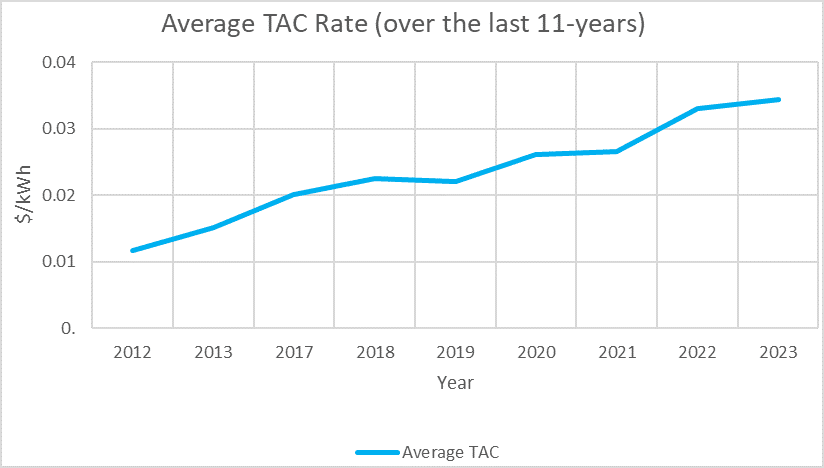
Moreover, TAC only covers the costs of historical and present investments in transmission, meaning that this graph does not include the effects of wildfire mitigation-related grid hardening investments or proposed transmission spending. In May 2022, CAISO released the first 20-Year Outlook for transmission planning and estimated a requirement of $30.5 billion. However, after years of analyzing transmission costs, the Clean Coalition has learned that the proposed up-front capital cost only represents a fraction of the total cost over the 40-50-year lifetime of the asset. The real project cost can be as high as 10 times greater in nominal dollars due to Operations & Maintenance (O&M) costs and guaranteed double digit rates of return over the 50-year lifetimes of transmission investments.
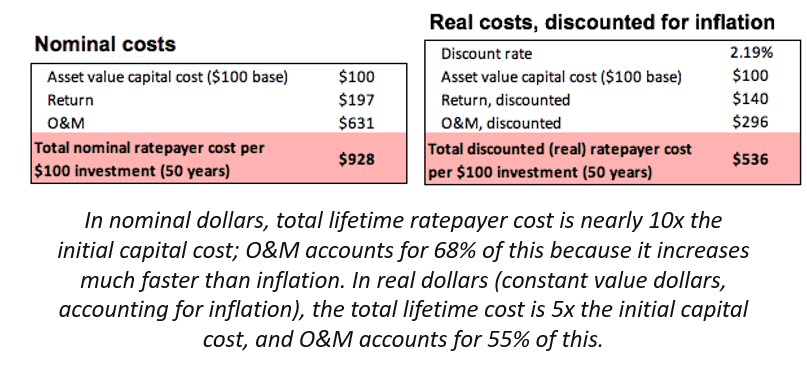
Therefore, the $30.5 billion proposed over 20 years is more likely to add about $300 billion to TAC, just for the new investments. As evidence, in the two most recent 10-year Transmission Plans, CAISO proposed 24 projects estimated at $2.9 billion in 2021-2022 and 46 projects estimated at $9 billion in 2022-2023. Each year, more new investments are being proposed to meet increasing capacity requirements, imposing greater-than-expected costs on the ratepayers. Moreover, the transmission grid hardening costs associated with the IOU’s wildfire mitigation plans are an additional cost on top of the rapidly rising transmission infrastructure investments being made.
Beyond transmission spending, the IOUs are spending billions each year on wildfire mitigation plans, wildfire insurance, wildfire victim payout funds, undergrounding, legacy generation contracts, and nuclear decommissioning. Unless these costs are reined in, electricity rates will continue to outpace inflation and burden Californians struggling to make ends meet. Implementing a high Fixed Charge will likely exacerbate the situation. A high Fixed Charge will reduce transparency in electricity rates, blinding the ratepayers from why costs are increasing and making it easier for already out-of-control spending to further run rampant.
7. What is the value derived from volumetric rates?
Volumetric rates pass prices ($/kWh) for energy, transmission, distribution, and Public Purpose Program costs directly to customers, ensuring that on average each rate class covers the costs that they incur. California’s rates are time-of-use (TOU), meaning that the volumetric prices change based on the time of day to accurately reflect the conditions and costs of using the grid. A higher price sends the signal to either reduce energy usage (temporarily or permanently) or consume energy that is generated onsite, and a lower price sends the signal that it is the optimal time to increase demand for energy.
Therefore, a high price differential between on-peak and off-peak periods sends a clearer signal to consumers and aligns the consumer’s interest in saving money with the ratepayer’s interest of reducing stress on the grid. Implementing a Fixed Charge, particularly a high Fixed Charge, dampens the volumetric signal sent to customers, lessening the impact that a customer’s behavior will have in reducing their monthly electricity bill.
Flagstaff Research found that when it comes to electrification, a blunt instrument like a high Fixed Charge is not ideal because electrification is not peak intensive. Two-thirds of electricity usage in electrification scenarios occurs during the winter off-peak period and only 3% of electricity usage occurs during the summer on-peak period. Instead, a TOU rate with a maximized price differential between the on-peak and off-peak periods is the most effective rate design structure to advance California’s electrification goals.
The spreadsheet shows that a highly differentiated TOU rate leads to a significant reduction in the blended rate for a home with electrified loads compared to the status quo, without increasing rates for the baseline (non-electrified) home. Importantly, the decrease in the levelized energy cost to $0.16/kWh is below the reduced volumetric rate even from most aggressive IOU Fixed Charge proposals. Thus, a highly differentiated TOU rate will reduce the annual operating cost by 50% without requiring the implementation of a Fixed Charge.
8. What will the effect of a high Fixed Charge be on deployments of Local Solar?
A high Fixed Charge reduces the value of Local Solar because even if imports of electricity from the grid fall to zero kWh, the ratepayer is still burdened with the Fixed Charge. In a study of Fixed Charges, the Rocky Mountain Institute found that the risk of grid defection begins once a charge exceeds $25 dollars per month. In California, the cost of delivering energy is already more than 50% of a monthly electricity bill; falling energy prices and high unavoidable utility charges will lead the state in the wrong direction. Grid defection would only lead to higher costs for the rest of the rate base as well as overbuilding of the grid. Putting the concept of grid defection aside, a high Fixed Charge would lengthen the payback period for a solar or solar+storage system, worsening the economics for customers taking service under the new Net Billing Tariff and disincentivizing others from making the investment. In that situation, the biggest consequences in the long term are an over-built transmission grid and higher electricity costs for all ratepayers, whether rich, poor, or anywhere in between. Less Local Solar means a far greater reliance on the transmission system, a much larger-scale transmission buildout, and higher costs (to be shouldered by the ratepayers through electric rates).
Consider the case study of September 22, 2022, the day when CAISO recorded the all-time peak load of 52.1 GW. As can be seen from the image below, on September 22, there was 12.5 GW of CAISO-interconnected solar, all of which required use of the transmission grid to be delivered to end-users. As a result, while 80% of the solar was still producing at the peak (4:57 p.m.), there was no reduction in peak transmission usage.
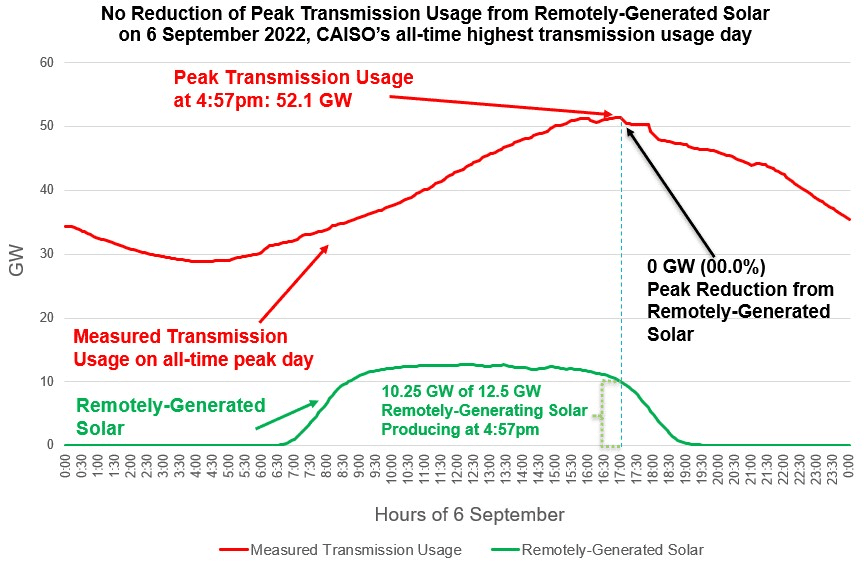
On the other hand, the peak reduction effect would be very different if the CAISO-interconnected solar had instead been Local Solar (deployed on the distribution grid). The second graph shows actual measured peak transmission usage (in red) and the reduced transmission usage due to Local Solar (in yellow) under a Local Solar scenario. The peak reduction effect from the Local Solar is 5.4 GW, or 10.3% of the all-time highest transmission usage that California has ever experienced, which would have been more than enough to ensure that no grid outages occurred – and that no transmission investments would be needed to accommodate peak transmission usage growth for many years to come.
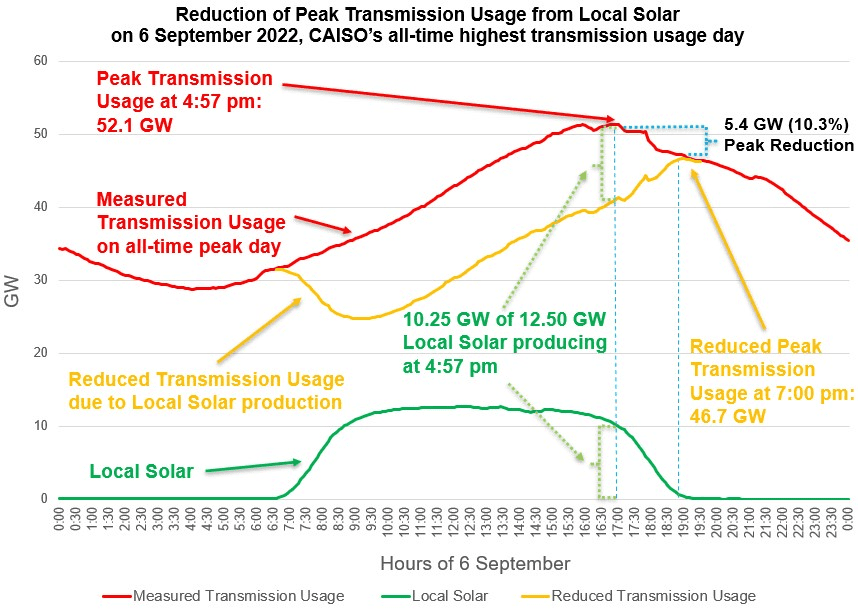
The two key ideas in this situation are that the Local Solar was still producing energy during the real system peak and that Local Solar reduces Peak Transmission Usage by close to 50% of the installed capacity, an effect that is amplified by local energy storage. Bringing down the peak transmission usage improves the efficiency of the transmission grid and reduces both line & congestion losses – and eliminates the need to invest in new transmission infrastructure to accommodate growth in peak transmission usage, which is the biggest reason for investing in new transmission infrastructure. Since the grid is planned based on the all-time peak (in the summer), peak reduction from Local Solar and demand flexibility will lead to major reductions in required transmission investments, saving ratepayers hundreds of billions of dollars over the next two decades alone.
Given the tremendous value that Local Solar provides to all ratepayers – whether rich, poor, or anywhere in between – deployments of Local Solar should be properly incentivized and compensated for this unparalleled value. Importantly, high Fixed Charges steal incentives and compensation from Local Solar – while maximizing profits for utilities by blinding customers and policymakers into approving transmission investments that transparent pricing signals will easily avoid.
9. Does a Fixed Charge make sense in the overall transition to real time rates?
California is moving toward a future where ratepayers increasingly can manage their energy usage and bills in as close to real time as possible. The hallmarks of the grid of the future for residential ratepayers will be electrification, smart appliances, and demand flexibility. In addition to lowering monthly electricity bills, flexible demand from 4-9 p.m. will reduce the system peak, preventing over-investment in the transmission grid. In this transition, a high Fixed Charge is an unnecessarily confusing step for ratepayers and will be a barrier to the transition to real time rates. The IOUs have done polling that concludes that Californians are still confused by TOU rates and are not overeager to transition to real-time rates. The increased amount of choice customers will have when real-time rates are implemented is quite daunting. Adding an interim step with a high Fixed Charge is moving in the wrong direction; if the goal is to send more precise pricing signals, then dampening the price signals with a high Fixed Charge will only make it more difficult for ratepayers to understand their bills. Furthermore, it is unclear whether a Fixed Charge will lead to the greatest savings. A presentation by the IOUs suggests that fully transitioning all customers to TOU rates will have the most favorable economic impact to California ratepayers overall.

If the CPUC authorizes a Fixed Charge, the Clean Coalition’s streamlined proposal is the best and most pragmatic option. However, a more ideal solution is to amend TOU rates to include a greater on-peak and off-peak price differential. Sending signals to change customer behavior, increase demand flexibility, and deploy Local Solar will be key to reducing peak demand and ensuring that over-investment in transmission infrastructure does not occur.

